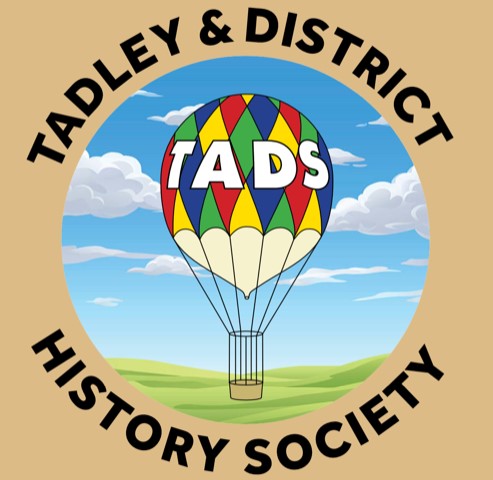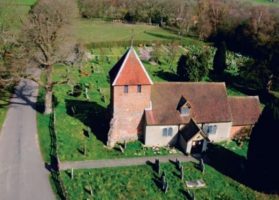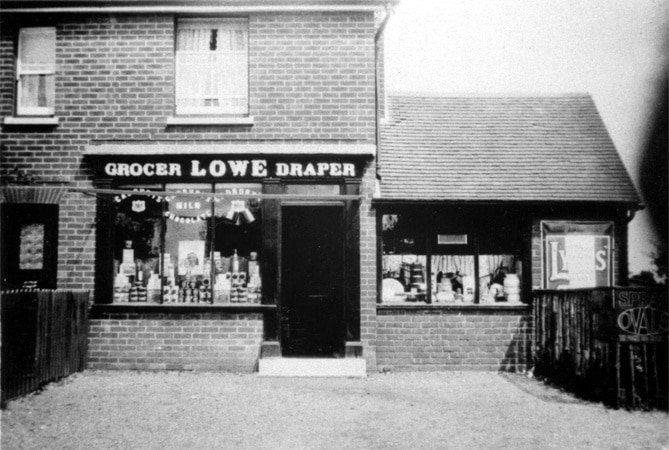Lowe’s shop – See Jean Pocock’s memories below…
A sample of Tadley memories…Tadley memories by Jean PocockTadley memories by Elsie SimpsonSergeant Leonard George RamptonBarry Howard |
Tadley memories by Elsie Simpson (nee West)
In the beginning…
I was born in 1918 at 32 West Street, which is still my home. My earliest memory is of my Grandmother, Mrs Elizabeth Monger of Burney Bit, Pamber Heath just before she died. She had been to Basingstoke market with her pony cart, as a carrier. This was a weekly event. Much to my surprise she had brought me a doll, a wonderful gift in those days. I well recall her funeral, my Grandmother being pulled on a bier to Tadley Old Meeting with the mourners walking behind in pairs, no hearse in those days, and not many cars.
What is now called The Treacle Mine pub was our nearest shop run by Mr Lowe. I remember being taken there by my sister sometimes, to have a pennyworth of sweets. These would be put in a piece of paper, which Mr Lowe would shape like an ice cream cone. In retirement he sold the shop, which became a private house. Then Mr Lowe’s son bought the shop at Mulford’s Hill, which was later sold to Whatmores and then to Budgens. Like his father he sold almost everything in the shop.
Work
Most men worked on the land, coppicing or broom making. The wages were small, but people grew most of their own vegetables, in their gardens, or on allotments – no allotments were down to grass in those days.
Stripping willow rods was another industry in Tadley. They were not grown here, but at Woolhampton by the Bath Road. My uncle rented rod beds there. These were cut in the winter, put in water and stripped in the spring, by a gadget known as a brake (steel bands attached to a piece of wood); some retained their skins so were known as brown rods, the stripped ones as white rods. Rod stripping was an annual event. A lot of women went to Brown’s Rod Yard at Heath End where the stripping was done. They were paid 3d (1.5p) for a ‘bolt’ of rods. Hard work! The area around what is now known as the Rowan Road Estate was always known to us as the Withey Beds, although I can never recall rods being grown there. The demand for English rods died out, as they could be bought cheaper from abroad (Belgium).
Play
Money was scarce so we certainly did not have the toys we would have liked. We made our own, such as a cricket set – three sticks and a piece of board for a bat. Yes we did have a ball! Another toy was Slippery Cap, a stick, split down about six inches from the top with one half of the split length cut away. This half was the cap. The stick was set in the ground, the cap replaced loosely and the stick was then hit with another stick to knock the cap off. The winner was the one who hit it farthest. Hoops, marbles, skipping ropes, and spinning tops, all had their season. Many a day I have run with a hoop down Tadley Hill from school.
We always had, as many people did, a pig reared at home every year to kill for Christmas. We children were well taught in dissection, watching Mr Nash cut the pig up. The liver, and something not heard of today – the crow – made a lovely meal.
Christmas was the time we liked best, to go carol singing round the houses, often to be told, ‘Come a little nearer Christmas’. No electric torches for us in those days, we had half a candle in a jam jar, secured in the jar by half of a ‘tater’. No one called them potatoes in those days. With a piece of string round the top for a handle we had a lantern. We had no fear in those days of walking the roads, after all we knew all of the children and the grown-ups we met. We were often told, ‘Time you children should be getting home’.
I well remember May Day at Tadley School. We all took part in the dances, often performed on the rectory lawn at St Saviours, and included the crowning of the May Queen. For our efforts we were rewarded by a tea party at Christmas.
Hop Picking

We used to break up from school at the end of August. The reason, nearly everybody in Tadley and the surrounding villages went hop picking. There were several farms in the Bentley area near Alton. I went to Coldrey, which was in a beautiful setting. We children thought of going there as our holiday.
Hop picking, Coldrey Farm nr Bentley, circa 1928
The mission men used to come from London for the hop picking season with scripture texts and first aid. Best of all were the ‘magic lantern shows’. Of course these were out of doors, so they would fix a white sheet up anywhere they could tie it. At Coldrey it was to the branches of an oak tree. To this day it is known to us as the ‘magic lantern tree’. A friend and myself recently had our photograph taken under this tree.
Mr Lowe from Tadley used to come to these hop farms with a van full of groceries once or twice a week. Mr Kelsey, a Tadley man, was not a very good hop picker so he was the baker, buying the bread from the bakery to sell to us. We were well catered for with a fish & chips man calling several nights a week.
At the end of hop picking, on being paid, every member of the family was given a large oval fruit bun known as the ‘Hopping Bun’. Those were happy days.
Teenage years
My aunt and uncle Mr and Mrs L Ford kept a small-holding in West Street – Brookhurst Farm. It is now a private house. I went there during my teenage years to work making butter, feeding the chickens and separating the milk. I will always remember the big oven, heated by burning wood in it. After the ashes were raked out and the oven wiped clean with a damp cloth, it was then ready for baking. As well as baking her own meat, cakes and pies my aunt would also bake for her neighbours.
My uncle was also a rod grower and I helped with the rod stripping, but the work I liked best was cutting up the hay in the chaff cutter and the mangolds in the mangold cutter. These came out like chips and were mixed with the chaff for the cow’s evening meal.
My childhood over, I remember Mr Miller the Headmaster of Tadley School saying to us who were leaving school, ‘There is a big wide world out there, go and see what you can make of it’. Little did we know that in a few years the boys would be fighting a war, we girls doing war work, and Tadley would be becoming a completely different village from that we had grown up in.
Serjeant Leonard George Rampton – official ‘war casualty’?
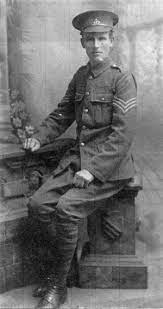
When the TADS Project Group researched the history of the men named on the Tadley War Memorial, they did not find any record for Leonard on the Commonwealth War Graves Commission (CWGC) website. This was confirmed by the CWGC in answer to a specific enquiry.
From the information the Project Group found, it was quite clear that Leonard Rampton had entered the regular Army as a fit young man in 1914 (?), and had been discharged as being ‘no longer physically fit for war service’ in December 1915, with the rank of Acting Serjeant. He died of ill health in February 1918, age 32, and it seemed clear that his Army service had destroyed his health.
He had been in the army during part of World War I and, although all his service had been in the United Kingdom, TADS still felt that there was a good case for him to be recorded as an official ‘war casualty’.
Therefore TADS submitted a case to the CWGC supported by copies of documents the Project Group had found during its research, including his Medical Discharge Certificate and Death Certificate.
The CWGC staff submitted the case to the National Army Museum whose decision was:
‘Despite the insight and conclusions offered by the Medical Board (1915) there is no reference to the condition that killed Corporal Rampton, tuberculosis of the kidney, anywhere within the report,’ … ‘thus limiting our ability to establish an authoritative link between his military service and his death. As a result, Corporal Rampton does not qualify for commemoration by the CWGC.’
So, although not officially recognised as a ‘war casualty’, Leonard Rampton is recorded on at least two local war memorials.
Family
Leonard George Rampton was born on 22 February 1886 at Tadley.
His parents were George and Edith Annie Rampton (née Lambert).
He was the eldest son of seven children, one of whom died: Elsie Ellen, Leonard George, Harry Edward, Adelaide Annie, Florence May, Evelyn Nellie and Archie Edwin.
In the 1901 Tadley census, aged 15 years, he was living with his parents in the white cottage in the lane variously known as Rampton’s, Back or Old Lane. His occupation was listed as an ‘Indoor Servant’, possibly at Heath End House, opposite the lane. In the 1911 census, aged 25 years, he was living at Herriard Park, Basingstoke. His occupation was listed as ‘Head Groom’ and he was lodging with other employees at the Park.
Leonard was unmarried.
Service record
Leonard served as a Corporal and Acting Sergeant (Service number: 337) in the 9th Cyclist Battalion of the Hampshire Regiment.
The Cyclist Battalion was established to facilitate rapid and cheap communication over tracks and difficult terrain in the field of action. It was definitely for keen cyclists only. The Hampshire Battalion carried out training on Salisbury Plain, carrying .303 rifles.
According to the Army Medical Board, it was as a result of exceptional hardship and exposure during troop training that caused Leonard to contract rheumatic fever in November 1914.
Leonard was discharged from the army as being “no longer physically fit for war service” following a number of medical problems including rheumatic fever, appendicitis and finally a valvular disease of the heart. He was discharged from the army on 26 December 1915 having served in locations in the United Kingdom.
On leaving the army he returned to Herriard Park where he remained until his death. At his funeral the eulogy described him as of a steady disposition and highly spoken of by all. Despite his illness he was always cheerful. He had been a respected member of the choir at Herriard for some years.
Died
Leonard died at Hurst Farm, Herriard, Basingstoke on Wednesday 27 February 1918, aged 32.
Commemorated
Leonard is buried at St Peter’s Church, Tadley. Although he did not die in army service and he does not have a Commonwealth War Graves Commission obituary, his name appears on both Tadley and Baughurst war memorials.
Decorations
No record of Leonard having received any medals has been found.
Return to the top of the page.
_______________________________________
Barry Howard’s Tadley Memories
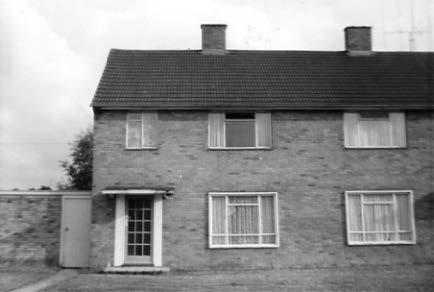
Arrival in Tadley
I’ve read and enjoyed many of the articles describing memories of Tadley prior to the massive changes wrought by the establishment of the AWRE. But maybe there’s now also a place for the reminiscences of those who came from all over the UK in the early 1950s to work at the AWRE and start a new life in the expanding village of Tadley. So, in the hope that it may be of interest to anyone who lived in Tadley during the 1950s and ’60s, here are my own reminiscences of growing up at that time.
My family moved to Tadley in late 1954 – the year that the AWRE became the UKAEA – when my late father took a job ‘behind the wire as an instrument technician. Moving from suburban Manchester to the countryside of Tadley was a big change for me as a six-year-old. The housing estate being built by Chiver’s builders for AWRE workers was still in the early stages of construction, so our first Winter was spent living in a caravan in a site at the bottom of Mount Pleasant. It was owned – I think – by an ex-travelling family by the name of Williams, who lived in a house on the Basingstoke road, almost opposite the junction with Franklin Avenue.
In the Spring of 1955, 24 Huntsmoor Road, (above) our home for the next 20 years, was ready to move into. What a wonderfully modern home we thought it was. Heating was from a small, light blue, stove enameled boiler, which sat in one corner of the kitchen, next to the hall-way door – (similar, but a different shape to, the one in the photo below). It was fueled by anthracite, which was stored in one of the two coal bunkers in the covered passage outside the kitchen door, and it also heated the tiny radiator in the dining room – and may also have provided hot water.
Hot water was also provided by an immersion heater in the airing cupboard water tank upstairs. But, other than the fireplace in the little-used front room, (the ‘best’ room), there was no heating in any other part of the house, so winter mornings getting dressed for school often took place in the kitchen.
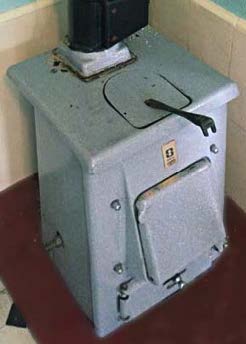
Childhood Play
The housing estate then under construction presented small boys like me with a wonderful, sprawling playground of half built houses, clad in an inviting climbing frame of scaffolding. Caterpillar excavators, bulldozers and dump trucks were usually just parked where they stood at the end of a working day, and just begged to be climbed over – although oil stains on clothes were always a risk. Then there were the empty and deserted airbase buildings – tailor-made for imaginative games – (light switches making for imagined morse code keys).
Surrounding all of this, there were lots of wooded areas. Whitedown woods had a ‘swing tree’, and a cluster of trees beside Bishopswood Lane, was known as the climbing trees. These woods also offered hiding places for all sorts of inventive games, and masses of places and materials from which to build hidden camps. The pine woods, next to Heath End House, was where we went dirt tracking on our bikes, and in the Autumn the broken paling fences round Heath End House were no great obstacle to the search for conkers. And the housing estate itself was also dotted with copses of pine and birch.
The building work itself produced lots of excavations – deep enough to form small lakes, and some even deep enough to be a bit dangerous, but ideal for chucking in empty bottles or bits of wood to serve as targets for stone-throwing contests. Much more dangerous was the temptation presented by a pair of defunct water towers which stood along Newchurch Road for some years – relics of the air base occupation. One or two my friends did take the standing dare to climb the dizzying height to the top, but I was never brave (or foolish) enough.
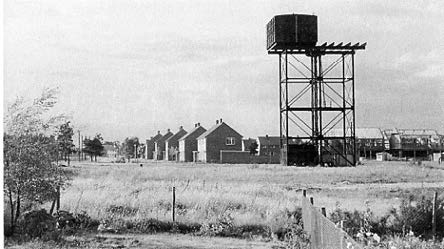
The workmen on the estate were not only mostly friendly, but often left empty fizzy drink bottles lying around in the half built houses – giving us extra pocket money if you took them back to Forbuoy’s at the Bishopswood Road shops, or to Jewell’s on Franklin Avenue, to claim the 3d refundable on any clean returns – as long as they still had their top in place.
School
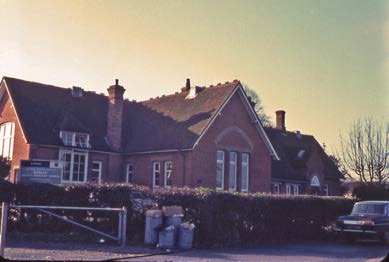
For the first 8-9 months of my life in Tadley the only school in the village was Tadley Junior School, beside the Green in old Tadley village. The Headmaster was a Mr Wilmot, and most of the children there were from local families, with only a few incomers like me. I wasn’t a pupil there long enough to have much in the way of memories, other than of playing football on the pitch on the Green.
After moving into the house on Huntsmoor Road, getting to Tadley school was more problematic than the previous walk down Mulford’s Hill and up Tadley Hill from the Mount Pleasant caravan site. But my Dad fitted a child saddle to the crossbar of his bike, and before going to work he’d cycle to the end of Huntsmoor Road, then down Southdown Road and Gutteridge Lane, along Church Road as far as Pound Farm and then up the narrow footpath, opposite Barn Hey.
Happily for him, he didn’t have to do this for very long, as the old Chivers canteen buildings on Newchurch Road were converted and ready to open for the start of the Autumn term of 1955, as the new Burnham Copse Junior School.
The Headmaster then, and for a long time to come, was Roger Searing, but my first and most important contact with the teaching staff was with my class teacher, Miss Taylor. Moving up the school, the class of 1956 next came under the fondly-remembered care of Miss (Mrs?) McDermott, whom I remember as a tall, softly-spoken lady who used to tease me about my Mancunian accent. Her class was housed in the “temporary” classrooms (left of the nearer doorway in the photo).

I remember, in particular, that with her and with other class teachers, we’d go for nature walks in the early Autumn, down Southdown Road and Gutteridge Lane, collecting leaves and other plants for the Nature Table. Some of us boys – usually the boys – would open up the ripe rose hips and try to put the itchy seeds down each other’s necks when the teacher wasn’t looking. A favourite spot on the walk was where Bishop’sWood stream passed under Gutteridge Lane, (photo left), and where we’d play ‘Pooh Sticks’. By the time we reached New Road it was time to return to school.
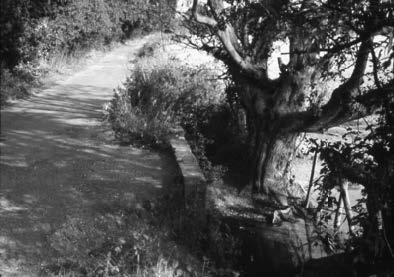
In my third year at Burnham Copse Miss McDermott passed us on to Mr Winter, (back in the main building now), on the Newchurch Road side of the school, (in the classroom in the centre of the photo). In one of the old air force buildings on the opposite side of Newchurch Road from these classrooms, (just along from the Community Centre) there was a tuck shop – at least in my first year at the school. It mostly catered for the Chivers workers, but it also did a good trade in sweets, and I particularly remember banana-split toffee bars, Parma Violets, sherbet dips and ‘Bubbly’ bubble gums. Very little sticks in my mind of my time in Mr Winter’s class, apart from winding raffia across round, tooth-edged pieces of cardboard, to make coasters; or weaving lengths of willow in and out of the upright pieces stuck round the edge of circular wooden bases, to make basket-work plant-pot holders.
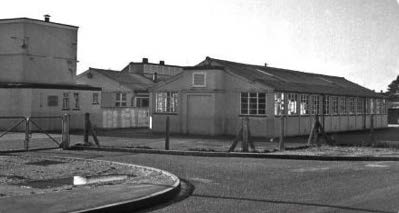
My class’s final year at Burnham Copse, under the venerable Mr Fabel, was dominated by the 11+ exam, which we all sat in the Spring of 1959, at Hurst Secondary Modern School in Baughurst. But, hugely important though it was, we didn’t spend all our time preparing for the exam – although I do remember my parents buying me books of IQ tests, which I actually quite enjoyed doing.
The alternatives to ‘chalk and talk’ at schools in those days were pretty limited. Occasional BBC Schools radio programmes and the odd gramophone record were seen as highlights, and I particularly remember listening to Debussy’s ‘Sunken Cathedral’ and singing along to ‘Marie’s Wedding’.
During my time at Burnham Copse, each year group went on a trip, but I only remember going on two trips. One was to Job’s Dairy (in Didcot, I think) – which also provided the break-time bottles of milk (1/3 of a pint), and the occasional treat of flavoured straws. The other was an unforgettable outing in my final year, to Whipsnade Zoo.
Shops
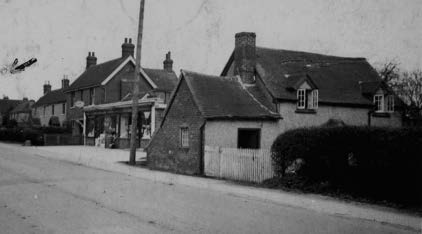
When we first moved to Tadley in 1956, the only shops that I can remember were Whatmore’s stores, opposite the Fox and Hounds pub at the top of Mulford’s Hill, and the small Post Office on Tadley Hill, opposite Allen’s Garage. There was also a shop and bakery on Tadley Hill, (just visible in the distant centre of the photo – right – below). Whatmore’s Stores (1950s) Tadley Post Office & Allen’s Garage (1950s)
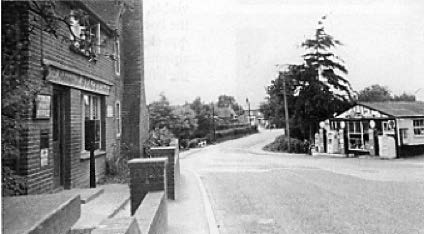
The AWRE estate also benefited from Mr King’s baker’s van, which served much more than bread. He started off, as I remember, serving customers from the rear doors of a small van, but he fairly soon graduated to a converted coach, and eventually opened up his own store on New Road. I also remember a fish and chip van coming round on Friday nights.
Along Franklin Avenue there was the Co-op and, at the junction of Franklin Avenue and Newchurch Road, was Jewell’s newsagents, which I think later became Richardson’s & Rabbett’s. A bit farther afield was the Baughurst Stores, and the Bungalow Stores, and I seem to remember Swan’s, which sold fruit and vegetables, and another shop named Coles – though I can’t recall what that shop sold or where it was located.
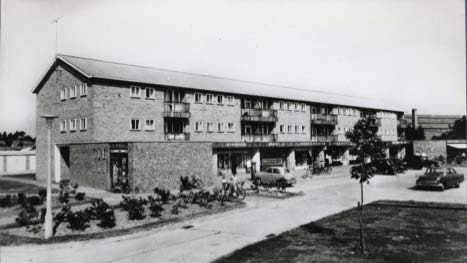
Some time in the late 1950s a parade of shops was built on Bishopswood Road. At one end, in a flint-faced annexe, was the office of C & G Ayres coal merchants, and as I recall, backing on to them was Swift Dry Cleaners. Next along was Simons Stores, a kind of early mini-supermarket – a real novelty in the days when customers were usually individually served.
Simon’s also had a sub-post office. Beside Simons Stores was Burwoods, selling (mainly women’s) clothes, wool and haberdashery. Next to Burwoods shop was Frank’s barbers which, for much of the 1950s, I’m fairly certain had been housed in one of the old air force buildings near to the Royal Cinema and Boundary Hall.
Parker & Ingram’s hardware store was next door to Frank’s, and there wasn’t much in the way of DIY and household items that you couldn’t find in there. Forbuoys newsagents and sweet shop, the next shop along, absorbed a huge amount of my limited pocket money – (6d a week in the mid-1950s) – on sweets such as lucky bags, Refreshers and Spangles, on rolls of pistol caps, comics and – come Autumn – on fireworks. Forbuoys was also where you went to get a paper round.
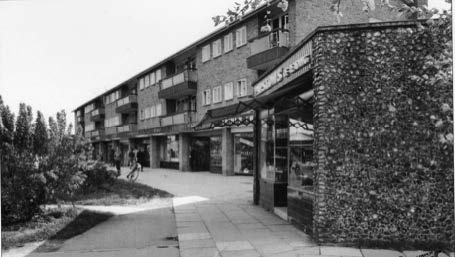
Marks butcher’s shop was next to Forbuoys, and at the end of the main parade of shops was Arthur Cooper’s off-licence. Finally, in a separate shop, was Parslow’s Bakery, and tucked away behind Parslow’s shop, was the optician’s premises of Mr T.S. Dear.
As Tadley grew, however, not only did Whatmore’s expand but another row of shops was built along from the junction with Mount Pleasant, opposite the Fox & Hounds. Bernards hardware store became a rival for Parker & Ingram, Eyles Florist set up next door, and there was also Job’s Dairy shop. Somewhat further along, at the top of Mulford’s Hill was
Hutchins Cycle shop, from where I was bought my very first bike – a blue Hercules – as the promised reward for passing the 11+.
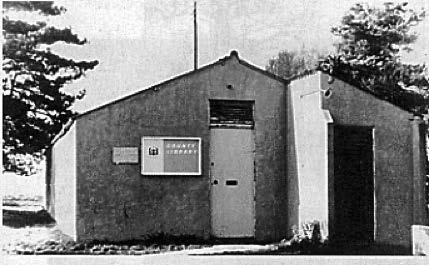
Not far from the Bishopswood Road shops, across a wide piece of waste ground, stood the local library, (formerly Hut 282) – run, for the whole of my young book-borrowing days – by the always helpful, Mrs Maule. Despite its limited stock, I rarely failed to find at least one or two books of interest, and particularly during the longer nights of Autumn and Winter, when playing out was only allowed at the weekends, I was a regular borrower.
Other facilities soon grew up during the 1950s, including Mr Parker’s dental surgery, in a single-storey premises on Newchurch Road, just across from the new St. Mary’s Church. Much longer established was the doctors’ surgery on Silchester Road, run by Drs Speight and Hawken. Banking facilities in the late 1950s and 1960s were at Barclays Bank on Basingstoke Road, close to the Cinema Royal and Boundary Hall. It was here that I took up my first job after leaving school, as office junior under manager William Balmforth and Chief Clerk John Mortimore. I wasn’t cut out for banking, and lasted barely a year. A smaller bank branch was soon opened by Lloyds, at the junction of Franklin Avenue and Basingstoke Road
Transport
Obviously, in the 1950s, car ownership was far less common than nowadays. My Dad’s first car was an upright, black Ford Popular, which he garaged in the huge thatched barn of Percy Appleton on Bishopswood Farm. Until Whatmores opened their own petrol station in the late 1950s cars could got petrol from Smith’s garage in Baughurst or the Esso garage on Heath End Road.
If you didn’t have a car you had to rely on the local bus services – the Thames Valley no.9 into Reading, every hour or so, and the no. 110 into Newbury, of about the same frequency. More regularly there was the 137 Wilts & Dorset bus into Basingstoke, which up to the early 1960s terminated at the corrugated iron stands of the Barge bus stop at the bottom of Station Hill.
What I remember most about the no 9 Reading bus, was its convoluted route through Berkshire villages – a 12-mile journey taking a full hour! There were also coaches, provided locally by Kents Coaches, based in their bus garage in Baughurst. These took younger children to and from school, and were also used for school trips. There was also a large bus garage in Tadley village down from the small Post Office sorting office.
Leisure
I guess this very much depended on individual interests. For the younger me, playing with my friends took up most of my time. Football games were usually played on the playing fields on Wigmore Road, or very occasionally on the triangular field at Heath End. I never belonged to the Cubs or Scouts, but I know that they met in a hut at the rear of the Royal
Cinema.
But I was a member – for a year or two – of 2403 Squadron of the Air Training Corps, (previously a detachment of 211 Basingstoke Squadron), which was run by Flying Officer Bailey and Warrant Officer Gates, which also met there.
For a while there was a Saturday cinema matinee organised for the younger children, in one of the ex-RAF buildings near to Boundary Hall, with Laurel and Hardy, Buster Keaton, Westerns and cartoons as the usual fare.
A Youth Club was held for many years at the Methodist Church on Newchurch Road, organised by Mr Dixon and providing table tennis, chess, record players and the chance to meet other teenagers. Teenagers and young adults could dance at a club, which I think was called the Ambassador Club, set up in one of the ex-service buildings adjacent to Hangar 5.
I lived away from Tadley since 1975, and chosen not to return. Having witnessed what happened to Basingstoke in the 1960s, I’ve preferred to remember Tadley it as it was whilst I was growing up
Return to the top of the page.
_______________________________________
